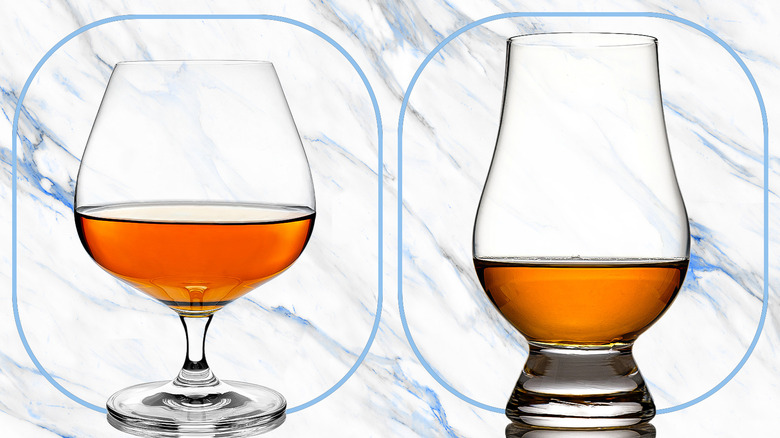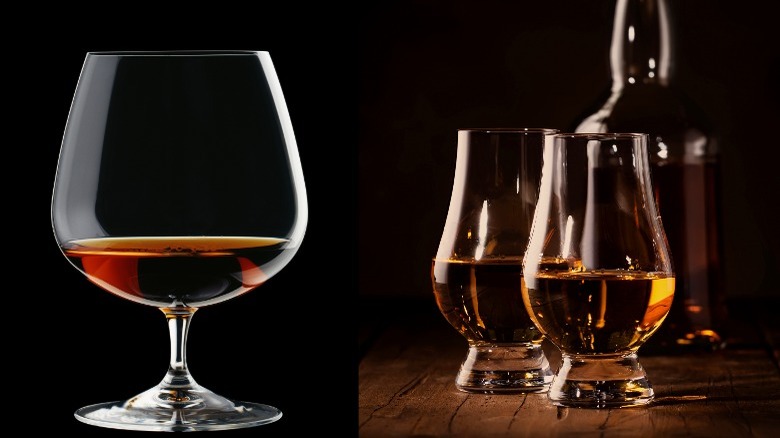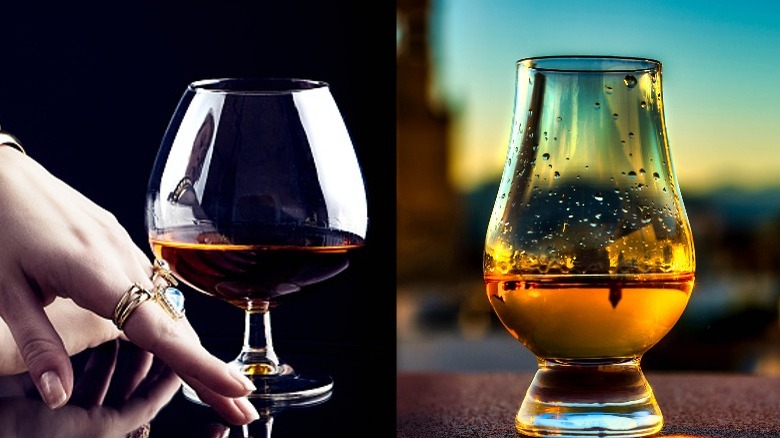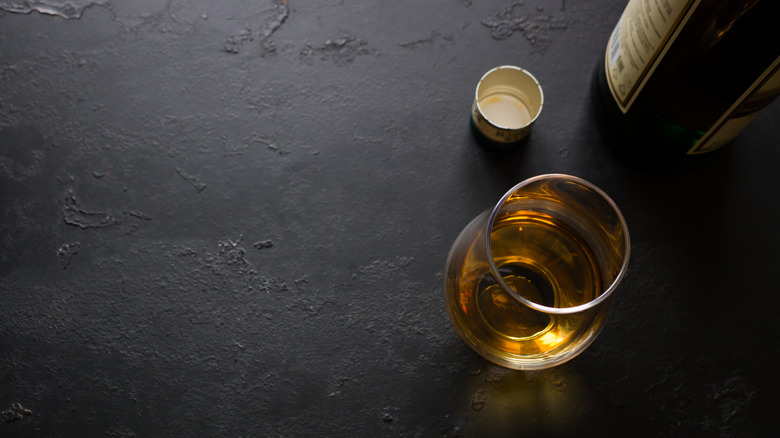What's The Difference Between Glencairn And Snifter Bourbon Glasses?
As with most subcultures, certain features of the bourbon community make almost no sense to an outsider but can be a source of heated debate for its members. Having a strong preference about the type of glass you drink your bourbon from makes about as much sense to casual drinkers as foodies having strong opinions about what type of plate their food arrives on. But trust us, it does actually matter.
To help illustrate why it's so important, let's look at two popular glasses in the bourbon world — the Glencairn and the snifter. As you can see, they're both made of glass and glass only. What matters is the shape. There are essentially three parts to a bourbon glass' design: the mouth, the body, and the stem. If you were to look straight at the glass; the mouth is the top, the body is the middle, and the stem is the bottom.
The shape of each part of the glass is going to affect how you hold it and how you drink it, both of which are going to impact the sensory experience of the drink. This is what makes bourbon glasses different from plates. Your plate doesn't change your food. At best, it's an aesthetic boost. Bourbon glasses, on the other hand, do change the drink's characteristics. The biggest impact is on smell, but taste is affected as well. Just remember to drink from whatever glass you enjoy, regardless of what others think.
Glory to Glencairn
The Glencairn is king in the world of whiskey, despite having only arrived on the scene in 2001. Inspired by the copita glass which is popular for sherry drinkers, the Glencairn was designed by the Scottish glassware company Glencairn Crystal. Its founder, Raymond Davidson, opened the crystal studio in 1981 and designed what would eventually become the Glencairn that very same year. The prototype stood dusty on the shelf for 19 years before Davidson's son noticed it one day and encouraged him to continue developing the design with the help of several master distillers from around the country.
Davidson initially designed the Glencairn in the hopes of creating a glass uniquely for whiskey, as it was still borrowing glasses designed for other spirits at the time. Little did he know how successful he would become at the task. Millions of Glencairns are sold around the world every year and, although competitors are vying for its throne, it will likely continue to be the whiskey glass of choice for bourbon connoisseurs for many years to come.
Snifters are sophisticated
Well-deserved or not, snifters have garnered a rather unfortunate reputation for being the glass of choice for the pompous and out of touch. They go by many names: balloon glasses, brandy snifters, and cognac glasses. Its exact origins are something of a mystery but we know that it was in use by the 19th century, possibly as an innovation that came out of the discovery of leaded glass though we can trace its ancestral heritage back to Roman times.
As you may have noticed from its other aliases, snifters are most commonly associated with brandy, but they have been used as a bourbon glass for years by many whiskey lovers. The most common criticism the snifter's detractors have is that the whiskey is warmed by the hand as you hold the glass. A warm whiskey evaporates more alcohol, which in turn changes the nose into something harsh and unpleasant. Some go so far as to say that this is the purpose of the glass, turning the snifter glass into something closer to an alcohol pipe. Instead of digesting the alcohol through your stomach, you inhale it into your lungs. While there are people who prefer to smoke alcohol, thankfully it's not very common and it's a strange claim to make that everyone who enjoys a snifter glass is secretly choosing it because they prefer to inhale their drink.
Starting from the bottom
The first thing you'll notice is that snifters have a delicate stem while Glencairns have a sturdy base. The stem of a snifter is designed to rest between your middle fingers with the body of the glass nestled in the palm of your hand. In fact, there's really no other way to hold the glass. You could grip it by the sides but the body is so bulbous that it becomes unwieldy and threatens to slip at the slightest bump. This is what causes the whiskey to warm up since there's a remarkable amount of your hand's surface area that is in contact with the glass exactly where the liquid is resting. This is often considered a flaw in the design, not a strength.
Glencairns get rid of the stem altogether. One reason is to avoid warming the whiskey and another is the aesthetics. Glass stems have an air of fragile elitism, a quality that is not often shared by whiskeys. Bourbon was born out of the rugged frontiersmen that first arrived in North America from Europe. These farmers were neither fragile nor elite and their drink of choice reflected that. The shape allows for several types of grip as well — from the base, from the top, or around the middle, all without creating too much heat. It has the added benefit of being able to lie on its side without spilling its contents.
Bulbous bodies are preferred
Both glasses have a wide, bulbous body. Snifters are exceptionally wide, which is how they earned the title of balloon glass, but neither glass is slim. The primary factor here has to do again with surface area — this time with the air. The wider the body, the larger the top layer of the contents. Which means more air is in contact with the bourbon.
There's a surprising amount of interaction between the oxygen in the air and the bourbon in your glass. If you've ever wondered why people swirl their glass before taking a sip, this is why. When you swirl the glass, especially in a bulbous glass such as these two, the contents rise up around the sides creating an immense amount of surface area. Fans of swirling say that it brings new oxygen into the spirit which releases the aromas that have been locked away after sitting for so long in the bottle and barrel. While swirling will help the aromas of the bourbon evaporate, critics of swirling say that it evaporates the alcohol too, resulting in a harsh sting on the nose.
Swirl or no swirl, the bulbous body is intended to provide ample opportunity for the aromas of the bourbon to release into the air. Snifters have a wider body so more evaporation will occur, but it's not a strong man contest and more evaporation doesn't universally equal better aromas. Glencairns will eventually achieve the same result, just at a slower pace.
The mouth matters
And finally, we have arrived at the mouth, also referred to as the rim. This is the top part of the glass and its shape is arguably the most important design element for how a bourbon smells. The more narrow the mouth, the more the aromas are going to concentrate like a funnel into your nostrils. Both the Glencairn and the snifter have a tapered mouth, meaning it's smaller relative to the body, but they aren't identical by any means.
Glencairns taper about two-thirds of the way up the glass and then it stops, turning into something like a flute for the last little bit. Snifters have a continuous taper but, since the body is so much wider, the mouth still ends up being wider than the Glencairn's. In practice, this means the aromas of the bourbon are going to be slightly more concentrated in a Glencairn than in a snifter. This is important for distillers since they need to be able to identify even the most subtle qualities of their product. For the refined bourbon connoisseur, looking to dive their nose deep into the golden amber bouquet, the Glencairn is an excellent choice.
Interestingly, this makes the snifter appear more relaxed than a Glencairn despite its reputation. There's a casualness about the snifter's wide mouth which lends itself to easy sipping relative to the furrowed brow of a Glencairn's concentrated nose. Of course, the personality of the drinker plays an important role.





